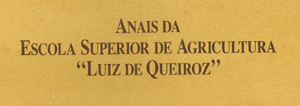Resumos
O objetivo deste trabalho foi o de comparar o efeito do calor, do SO2 e do ácido ascorbico, visando determinar qual o método mais eficiente para controlar o escurecimento enzímico de cada uma das frutas e hortaliças estudadas. Os resultados mostraram que para a banana, pêssego, maça, cenoura, couve-flor e palmito, o calor foi o melhor agente inativador do sistema enzímico responsável pelo escurecimento. O SO2 foi mais eficiente para a pera, e para o figo e batata, o melhor agente inibidor foi o ácido ascórbico.
Inativação de enzimas; frutas; hortaliças; polifenol oxidase; peroxidase
The objective of this work was to study the comparative effect of heat, S0(2) and ascorbic acid treatments on polyphenol oxidase and peroxidase activities, aiming to select the best method to control the enzymatic browning for each of the fruits and vegetables studied. The results showed that for banana, peach, apple, carrot, cauli-flower and heart-of-palm, heat was the best inactivating method of the enzyme system responsible for browning. S0(2) was more efficient for pear, whereas ascorbic acid was considered the best inhibitor for fig and potato.
Enzyme inactivation; fruits; vegetables; polyphenol oxidase; peroxidase
ARTIGOS
Efeito comparativo do calor, S02 e ácido ascórbico na atividade da polifenol oxidase e peroxidase de algumas frutas e hortaliças* * CNPq. Trabalho apresentado na "IFT 48th Annual Meeting", realizada de 19 a 22 de junho de 1988, em New Orleans, La., EUA.
Comparative effect of heat, S02 and ascorbic acid on polyphenol oxidase and peroxidase activities of some fruits and vegetables
J.N. NogueiraI; E. SilvaII
IDepartamento de Tecnologia Rural da E.S.A. "Luiz de Queiroz" da Universidade de São Paulo- 13.400 - Piracicaba. SP
IIDepartamento de Alimentos e Nutrição, FCF/UNESP, Araraquara, SP
RESUMO
O objetivo deste trabalho foi o de comparar o efeito do calor, do SO2 e do ácido ascorbico, visando determinar qual o método mais eficiente para controlar o escurecimento enzímico de cada uma das frutas e hortaliças estudadas.
Os resultados mostraram que para a banana, pêssego, maça, cenoura, couve-flor e palmito, o calor foi o melhor agente inativador do sistema enzímico responsável pelo escurecimento. O SO2 foi mais eficiente para a pera, e para o figo e batata, o melhor agente inibidor foi o ácido ascórbico.
Termos para indexação: Inativação de enzimas, frutas, hortaliças, polifenol oxidase, peroxidase.
ABSTRACT
The objective of this work was to study the comparative effect of heat, S02 and ascorbic acid treatments on polyphenol oxidase and peroxidase activities, aiming to select the best method to control the enzymatic browning for each of the fruits and vegetables studied.
The results showed that for banana, peach, apple, carrot, cauli-flower and heart-of-palm, heat was the best inactivating method of the enzyme system responsible for browning. S02 was more efficient for pear, whereas ascorbic acid was considered the best inhibitor for fig and potato.
Index terms: Enzyme inactivation, fruits, vegetables, polyphenol oxidase, peroxidase.
Texto completo disponível apenas em PDF.
Full text available only in PDF format.
AGRADECIMENTOS
Agradecemos ao CNPq pelo auxilio concedido.
Entregue para publicação em: 31/08/89
Aprovado para publicação em: 13/02/90
- BRAVERMAN, J.B.S. Introduction to the biochemistry of foods. Amsterdam, Elsevier, 1963. 336p.
- ESKIN, N.A.M.; HENDERSON, H.M.; TOWNSEND, R. J. Biochemistry of foods. London, Academic Press, 1971. 239p.
- FERHMANN, H. & DIAMOND, A.E. Peroxidase activity and phytopora resistance in different organs of the potato plant. Phytopathology, Lancaster, 57:69-72, 1967.
- GUTTERSON, M. Vegetable processing. Park Ridge, Noyes Data, 1971. 335p.
- IADEROZA, M.; DRAETTA, J.S.; PADULA, M. Polifenoloxidase da polpa de duas cultivares de abacate. Coletânea do ITAL, Campinas, 11:53-64, 1980.
- JANKOW, C.I. Thermal inactivation of oxidases in fruits and vegetables. Lebensmittel Wissenchaft undTechnologie, Zurich, 10:23-35, 1963. Apud Chemical Abstracts, Easton, 63:7578, 1965.
- JOSLYN, M.A. & BRAVERMAN, J.B.S. The chemistry and technology of the pretreatment and preservation of fruit and vegetable products with sulphur dioxide and sulfites. Advances in Food Research, New York, 5:97-160, 1954.
- NOGUEIRA, J.N. Influência de alguns métodos de processamento nas propriedades organoléticas da maça em pedaços: variedade Bruckner do Brasil. Anais da Escola Superior de Agricultura "Luiz de Queiroz", Piracicaba, 30:227-39, 1973.
- NOGUEIRA, J.N. Estudo sobre o processamento do palmito (Euterpe edulis Mart.) por apertização. Piracicaba, 1979. 141p. (Livre-Docência - Escola Superior de Agricultura "Luiz de Queiroz"/USP)
- PARK, Y.K.; SATO, H.H.; ALMEIDA, T.D.; MORETTI, R.H. Polifenoloxidase de manga (Mangifera indica, var. Haden). In: REUNIÃO ANUAL DA SOCIEDADE BRASILEIRA PARA O PROGRESSO DA CIÊNCIA, 32., Rio de Janeiro, 1980. p.56. (Resumo).
- PONTING, J.D. The control of enzymatic browning of fruits. In: SCHULTZ, H.W. ed. Food enzymes, Westport, AVI, 1960. p.105-24.
- PONTING, J.D. & JOSLYN, M.A. Ascorbic acid oxidation and browning in apple tissue extracts. Archives of Biochemistry, New York, 19:47-63, 1948.
- YANKOV, S.I. Heat inactivation of oxidizing enzymes in some fruits and vegetables. Izvestija Vysshih Uchebnyh Zavedenij. Fisika, Parklawn Drive, 2:29-32. Apud Chemical Abstracts, Easton, 59:7851, 1963.
Datas de Publicação
-
Publicação nesta coleção
06 Maio 2009 -
Data do Fascículo
1989
Histórico
-
Aceito
13 Fev 1990 -
Recebido
31 Ago 1989

